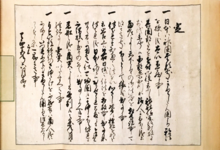The Bateren Edict (Bateren Tsuihorei) was issued by Toyotomi Hideyoshi in Chikuzen Hakozaki (currently Higashi-ku, Fukuoka City, Fukuoka Prefecture) on July 24, 1587, regarding Christian missionary activities and Nanban trade.[1][2] Bateren is derived from the Portuguese word padre, which means "father".

The original document can be found among the "Matsuura Family Documents" and is stored in the Matsuura Historical Museum in Hirado City, Nagasaki Prefecture. Normally, the document called "Bateren Edict" refers to the five documents dated July 24, refers to "Matsuura Family Document", but also refers to memoranda dated June 18, 1933, in the "Goshuinshi profession old class" discovered in the Jingu Library of Ise Jingu in 1933. Furthermore, since the discovery of the latter 11 "senses", various discussions have been held on the reasons for the differences from the five expulsion orders and the meaning of the two documents.
Transcriptions
editFirst Version
editThe first edict was issued on the 18th day of the 6th month of the 15th year of the Tenshō era, according to the traditional Japanese calendar, which corresponds to the date July 24, 1587, in the Gregorian calendar.
- 伴天連門徒之儀ハ、其者之可為心次第事、
- 国郡在所を御扶持に被遣候を、其知行中之寺庵百姓已下を心ざしも無之所、押而給人伴天連門徒可成由申、理不尽成候段曲事候事、
- 其国郡知行之義、給人被下候事ハ当座之義ニ候、給人ハかはり候といへ共、百姓ハ不替ものニ候條、理不尽之義何かに付て於有之ハ、給人を曲事可被仰出候間、可成其意候事。
- 弐百町ニ三千貫より上之者、伴天連ニ成候に於いてハ、奉得公儀御意次第ニ成可申候事、
- 右の知行より下を取候者ハ、八宗九宗之義候條、其主一人宛ハ心次第可成事、
- 伴天連門徒之儀ハ一向宗よりも外ニ申合候由、被聞召候、一向宗其国郡ニ寺内をして給人へ年貢を不成並加賀一国門徒ニ成候而国主之富樫を追出、一向衆之坊主もとへ令知行、其上越前迄取候而、天下之さはりニ成候儀、無其隠候事。
- 本願寺門徒其坊主、天満ニ寺を立させ、雖免置候、寺内ニ如前々ニは不被仰付事、
- 国郡又ハ在所を持候大名、其家中之者共を伴天連門徒押付成候事ハ、本願寺門徒之寺内を立て候よりも不可然義候間、天下之さわり可成候條、其分別無之者ハ可被加御成敗候事、
- 伴天連門徒心ざし次第ニ下々成候義ハ、八宗九宗之儀候間不苦事、
- 大唐、南蛮、高麗江日本仁を売遣侯事曲事、付、日本ニおゐて人の売買停止の事。
- 牛馬ヲ売買、ころし食事、是又可為曲事事。
右條々堅被停止畢、若違犯之族有之は忽可被処厳科者也、
天正十五年六月十八日 朱印
— 天正十五年六月十八日付覚
Translation
edit- Being a Christian should be at the discretion of the person.
- It is unreasonable for the daimyo to force its people to become a Christian even though the temples and peasants in the territory are not willing to do so.
- It is only temporary that the daimyo orders to rule the country, so even if the daimyo changes, the peasant does not change, so it is possible for the daimyo to rule the country wrong. if the daimyo says something wrong, he can do what he wants.
- A daimyo with more than 3,000 Kan and 200 towns can become a Christian with the permission of Hideyoshi.
- Those (daimyo) who have less may be up to the person's wishes, like Hassyu-Kussyu (number of buddhism sects), since it is religious matter
- have heard that Ikko-shu may show more than Ikko-shu for Christians, but Ikko-shu not only does not pay the annual tribute to the daimyo by setting up a temple territory (Jinaicho) in the country, but also tries to make whole Kaga province Ikko-shu. Togashi, the daimyo, was banished and ordered to be ruled by a priest of the Ikko sect. It's a fact that can't be hidden anymore.
- The monks of Honganji temple are allowed to set up a temple in the land of Tenma (= Tenma Honganji), but this kind of temple territory (of the Ikko sect) has never been allowed.
- It is not possible for a daimyo with a national county or territory to make his vassals Christians than for a sect of Honganji to set up a temple territory. Those who do not understand can be punished.
- It does not matter that a person with a lower status (rather than a daimyo, etc.) becomes a Christian at will, as in the case of the eight sects and nine sects.
- It is unreasonable to sell Japanese to China, Nanban, and the Korean Peninsula. Therefore, in Japan, the buying and selling of people is prohibited.
- Buying and selling cows and horses, and killing and eating them are also a shame.
However, Hideyoshi says that he will punish those who take this opportunity to harm the missionaries. Although compulsory conversion to Christianity is prohibited, the people are free to believe in Christianity on their own initiative, and the daimyo can become a believer with the permission of Hideyoshi. In fact, it guaranteed freedom of religion. Immediately after this, Hideyoshi took Nagasaki from the Jesuits and made it a tenryo.
Second Version
editThe second version of the edict was issued the next day, on the 6th month, 19th day of the year Tenshō-15, which corresponds to July 25, 1587.
定
- 日本ハ神國たる處、きりしたん國より邪法を授候儀、太以不可然候事。
- 其國郡之者を近附、門徒になし、神社佛閣を打破らせ、前代未聞候。國郡在所知行等給人に被下候儀者、當座之事候。天下よりの御法度を相守諸事可得其意處、下々として猥義曲事事。
- 伴天連其智恵之法を以、心さし次第二檀那を持候と被思召候ヘバ、如右日域之佛法を相破事前事候條、伴天連儀日本之地ニハおかせられ間敷候間、今日より廿日之間二用意仕可歸國候。其中に下々伴天連儀に不謂族申懸もの在之ハ、曲事たるへき事。
- 黑船之儀ハ商買之事候間、各別に候之條、年月を經諸事賣買いたすへき事。
- 自今以後佛法のさまたけを不成輩ハ、商人之儀ハ不及申、いつれにてもきりしたん國より往還くるしからす候條、可成其意事。
已上
天正十五年六月十九日 朱印
— 吉利支丹伴天連追放令
Translation
edit- Even though Japan is a country protected by its own gods, it is completely unreasonable to introduce the evil law from the Christian country.
- I have never heard that local people are brought closer to the (Christian) teachings, made (Christian) believers, and destroyed the temples and shrines. It is only temporary that (Hideyoshi) has the daimyo of each country rule the territory. You should obey the law from the Tenka (Hodeyoshi's rule) and do various things as its rule but it is unreasonable not to do it with a sloppy attitude.
- Christian missionaries, by their wisdom, thought that they would leave it to the free will of the people to make them believers, but as I wrote earlier, they violated Japanese Buddhist law. It is not possible to have a Christian missionary in Japan, so get ready in 20 days from today and return to the Christian country. It would be a shame if anyone insisted that he was not a Christian missionary even he is.
- Since the trade ship is coming to do business, it is different from this (Edict), so continue to do business in the future too.
- From now on, it is permitted to visit Japan from the Christian country at any time, even if you're not a merchant, as long as it doesn't interfere with Buddhist law, so I'll allow it.
6th month, 19th day, Tenshō era, 15th year
References
edit- ^ Boscaro, Adriana (1973). "Toyotomi Hideyoshi and the 1587 Edicts Against Christianity". Oriens Extremus. 20 (2): 219–241. ISSN 0030-5197.
- ^ Kang, Etsuko Hae-Jin (1997), Kang, Etsuko Hae-Jin (ed.), "The Tokugawa Taikun Diplomacy and Korea", Diplomacy and Ideology in Japanese-Korean Relations: From the Fifteenth to the Eighteenth Century, London: Palgrave Macmillan UK, pp. 136–166, doi:10.1057/9780230376939_6, ISBN 978-0-230-37693-9, retrieved 2022-07-04